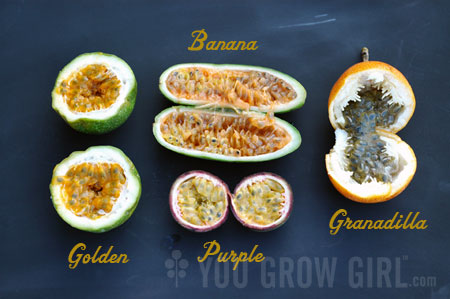
The other day I happened upon a store that was selling four different types of passion fruit (passiflora) simultaneously. While I have tried some of these types separately before, finding four at once posed an excellent opportunity to judge them against each other.
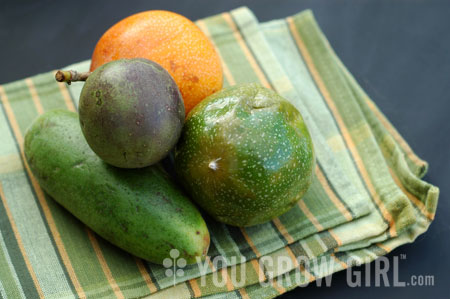
Then I figured why not try to collect the seeds and grow them while I’m at it? I have grown passion fruit vine in the past but have never tried to start them from seed. This will be an interesting experiment. The trick seems to be to start the seeds fresh, straight out of the fruit so I’d better get on it quickly. Dried, older seeds can take ages to germinate, although I figure it’s worth the experiment to try the seeds in either state for the heck of it just to see what happens.
The other negative I expect to come up is that the fruit I bought are probably commercially grown hybrids. As a result I can’t be sure of how the plants will turn out. However, I’m not worried about it since I’m growing for the flowers, not the fruit. If they germinate, great. If not, oh well.
The Results of the Taste Test:
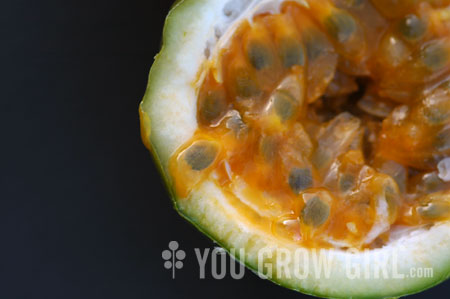
Golden Passion Fruit (Passiflora edulis var. flavicarpa)
Apparently this belongs to the same species as purple passion fruit but the taste is very different. In a word, yuck. However, I am reticent to leave that as my definitive judgment. When imported, these kinds of tropical fruit are often tasteless and horrible compared to those picked fresh off the vine. Based on online photos, I’d hazard a guess that ours was simply not ripe yet. I’d like to try this type again under different circumstances.

Banana Passion Fruit (Passiflora tripartita var. mollissima) or (Passiflora tarminiana) aka Curuba
I did not care for the fruit to be honest, but I’m willing to chalk it up to produce picking error on my part. Chances are it just wasn’t a good sample. Regardless, this is the variety I am most excited about growing. The powdery soft, pink flowers dangle from the vine and remind me of plastic caps that covered the string of lights on the Xmas tree when I was a kid.
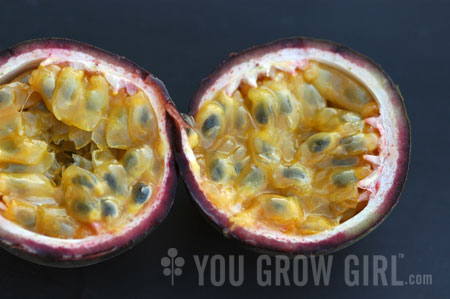
Purple Passion Fruit (Passiflora edulis)
I’ve tasted this type of passion fruit both here and purchased from a farmers’ market for mere pennies in Mexico where I am sure it was ripe and straight off the vine. The taste was comparable and very good in both conditions. It’s sweet with a sour kick. The seeds are crunchy and edible so you might as well just eat it all since they are difficult to separate from the gelatinous fruit.
The flowers of this species are your prototypical passiflora, at least in my region. I say this not to suggest that they are dull, simply that this is the vine most commonly seen for sale at corner shops and garden centres here in Toronto. For many years this was the only species I could find locally, until the demand rose and other varieties started to appear.
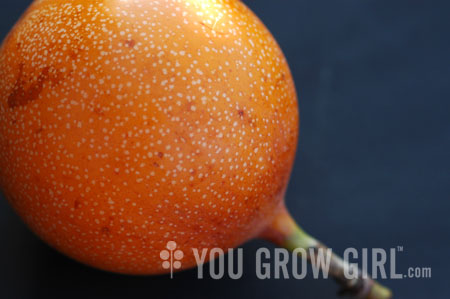
Granadilla (Passiflora ligularis)
I often see this type sold in Latin American food stores. It is the best tasting of the lot as far as I’m concerned. It has the sweetest and least sour taste and the seeds have a very satisfying crunch. Its droopy, purple and white flowers are very unusual and remind me of a of sea creature.
Growing Passion Fruit
Passion fruit vines aren’t hardy to colder, northern regions of the world, but with a few measures you can keep them alive for years and years. I grew one in a very large container (about 14″ deep) for several years consecutively and even managed to produce a tiny, inedible fruit from another variety during one particularly warm summer. It may have been tasteless and almost empty inside, but I sure was proud of it. Passion fruit vines requires a longer summer to produce real fruit, but it is still worth growing for the flowers.
Oh, the flowers. There are so many incredible flowers in interesting shapes, colours, and intoxicating smells. One could devote their entire growing life to this genus alone since there are hundreds of different species kicking about across the world.
Passion flower vines grow big and lush very quickly. As a result they need rich, fertile soil to flourish. I have found small, straggly plants growing in horribly dry, nearly dead soil in vacant lots in Mexico. These plants were alive, just not very nice to look at and the fruit were impossibly tiny. Passion flowers also need a lot of sun and decent moisture and humidity. If you plan to grow these indoors in a really dry apartment or electric-heated house I would suggest giving them a spray now and again through the winter months when the air is driest.
Overwintering
In the past, I overwintered my passiflora plants by bringing their containers inside just before the first frost. I forced them into dormancy by cutting the vine back hard down to the lower branches and placing the pots in our cool (but not freezing) hallway where there is dim north facing light. Basements and cold mudrooms also make a good location. I watered the soil every once and a while to be sure the plants didn’t go dry, but tried to keep them on the dryer side of moist. The plants went back outside in the spring once all fear of frost was behind us.
I know others who have simply grown passiflora indoors year round in a very sunny window. When it got to be too big and unruly they would cut it back hard and start again.
Well here in Nicaragua there’s only one type of passionfruit, that i’ve seen at least, and judging from your photos it appears to be the Golden variety. it has a tangy tart absolutely delicious flavor! it is used mainly in fresh juices or rum drinks. there is also a fruit called “granadilla” –it is ENORMOUS, like the size of a watermelon. haven’t tried it yet. thanks for the info!
liz
It is so tempting to get infatuated by another genus. But so far I’ve resisted Passiflora. I just don’t have enough room! Well maybe one plant.
Don’t do it Barry!
Liz: I’ve heard of that large granadilla but have never seen one in person. I very much doubt they would bother to export that to Canada. Your description of the golden/yellow passion fruit gives me hope that i just chose poorly.
Do it Barry!
Bre: Enabler!
aren’t we all enablers around here??
Kate: Definitely. I’m the biggest one.
Some strains of native Passiflora incarnata produces tasty fruit, and the ‘Incense’ hybrid produces delicious fruit.
My incense vine has produced about fifty egg sized fruits this year. It grows faster and has fewer pest problems than other fruit producers, and it looks great. This variety is widely grown for flowers, the fruit isn’t often mentioned.
Many people with passionflowers never see fruit because they require a pollinator.
You know, I am sure that passion fruit is delicious, but I just can not get over how the insides look kind of like puke. D:
I love passion fruit. I grew up in South America and we enjoyed it in many forms, my favorite it as juice. I wish I could get them locally, but they’re tough to come by in NE Ohio.
I’ve been thinking of replacing the trumpet vine I have at the back of my garden covering up the neighbor’s ugly garage. I was planning to go with a passion flower, but I got scared off by reading that they were vigorous to the point of taking over. Have you found that? And, do you have any tips to keeping them controlled? I live and garden in NYC – Zone 7. I just love the outrageous flowere – fruit would be an unexpected boon, not my reason to plant them.
oh man, so that’s the mystery fruit (several varities) I enjoyed while on vacation in the Dominican Republic–nectar of the gods, that & Roland brand mustard were 2 culitary highlights at the buffet tables xox
I would love to try to grow it, the flowers are amazing
I have this mysterious variety of passionfruit in my back yard in Hawaii. It looks like a egg shaped yellow orange squishy rubbery skinned fruit with insides that look like the typical “golden” passion fruit. The flowers are beautifully fragrant purple and the vines are incredibly prolific. Can’t find any photos or descriptions on the internet that match. does anyone know what these are?
I have this mysterious variety of passionfruit in my back yard in Hawaii. It looks like a egg shaped yellow orange squishy rubbery skinned fruit with insides that look like the typical “golden” passion fruit. The flowers are beautifully fragrant purple and the vines are incredibly prolific. Can’t find any photos or descriptions on the internet that match. does anyone know what these are?
The banana one looks really cool. I’m going to have to hunt that one down.
In Colombia where I come from we eat all of them regularly. The first one is used for fruit juice, blend it with water and some sugar, run it through a strainer, add some ice and it is a perfect fresh tart juice. Curuba is prepared the same way, you can add milk as well and you have a good juice, although not as popular. Granadilla is actually the only variety that is eaten as is. It is very good tasting and sweet. It is usually one of the first fruits that is given to babies. The fist two types are also added to shaved ice and some condensed milk. It is said to be great for hang overs.
i’ve never eaten a fresh passion fruit.. all i tried is the juice and the puree.. and the candies.. haha
We have a golden passionfruit vine growing all along our side fence and it tastes great when picked fresh and ripe; tangy-tart but sweet. Comparable to the purple kind (my aunt had one of those so I’ve tasted them fresh too). I have strong memories of eating golden passionfruit from the vine all summer as a kid. Interesting that you talk about crunching the seeds – as far as I know, most Australians swallow the seeds whole.
eve’s garden: They’re definitely prolific under the right conditions (warm, humid, lots of moisture). If they’re too dry or it’s cold though, they won’t grow nearly as much.
Definitely prolific to the point of taking over, although if you’re growing the tropical variety, it will be an annual in NY, so that shouldn’t be an issue. I put up with their aggressive ways (have 5 different varieties, not all fruiting) because they have beautiful flowers and are a host plant to couple of local butterflies.
Not big on the fruits out of hand, since the taste is so strong. However, I’ve found the flavor works well in a peach jam or in a Mimosa.
What great info. I’ve just got back from Ecuador where I tried three kinds and the granadilla was my favourite too – I smuggled seeds home and even if I don’t get fruit the plant will remind me of the amazing time I had eating the freshest and most incredible fruits of my life. Sigh….